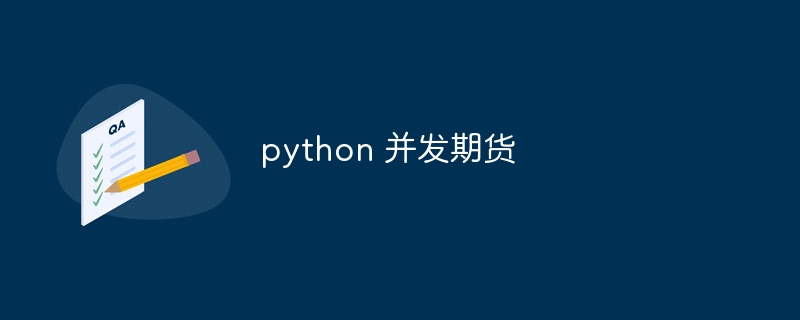◎欢迎参与讨论,请在这里发表您的看法、交流您的观点。
python 并发期货
ID:20142 / 打印
未来
future 是一个容器,可以保存计算结果或计算期间发生的错误。创建 future 时,它以 pending 状态开始。该库不打算手动创建此对象,除非出于测试目的。
import concurrent.futures as futures f = futures.future() assert(f._result is none) assert(f._exception is none) assert(f._state == 'pending')
pending 状态表示用户请求的计算已注册到线程池中并放入队列中,但尚未被任何线程拾取执行。一旦空闲线程从队列中获取任务(回调),future 就会转换为 running 状态。 future 只能在处于 pending 状态时被取消。因此,在 pending 和 running 状态之间存在一个时间窗口,在此期间可以取消请求的计算。
import concurrent.futures as futures def should_cancel_pending_future(): f = futures.future() assert(f._state == 'pending') assert(f.cancel()) assert(f._state == 'cancelled') def should_not_cancel_running_future(): f = futures.future() f.set_running_or_notify_cancel() assert(f._state == 'running') assert(not f.cancel()) def cancel_is_idempotent(): f = futures.future() assert(f.cancel()) assert(f.cancel()) should_cancel_pending_future() should_not_cancel_running_future() cancel_is_idempotent()
线程池中请求的操作可以完成计算值或导致错误。无论结果如何,未来都会过渡到 finished 状态。然后结果或错误将存储在相应的字段中。
import concurrent.futures as futures def future_completed_with_result(): f = futures.future() f.set_result('foo') assert(f._state == 'finished') assert(f._result == 'foo') assert(f._exception is none) def future_completed_with_exception(): f = futures.future() f.set_exception(nameerror()) assert(f._state == 'finished') assert(f._result is none) assert(isinstance(f._exception, nameerror)) future_completed_with_result() future_completed_with_exception() 要检索计算结果,请使用 result 方法。如果计算尚未完成,此方法将阻塞当前线程(从中调用结果),直到计算完成或等待超时。
如果计算成功完成且没有错误,则 result 方法返回计算值。
import concurrent.futures as futures import time import threading f = futures.future() def target(): time.sleep(1) f.set_result('foo') threading.thread(target=target).start() assert(f.result() == 'foo') 如果计算过程中发生异常,结果将引发该异常。
import concurrent.futures as futures import time import threading f = futures.future() def target(): time.sleep(1) f.set_exception(nameerror) threading.thread(target=target).start() try: f.result() raise exception() except nameerror: assert(true)
如果方法在等待时超时,则会引发 timeouterror。
import concurrent.futures as futures f = futures.future() try: f.result(1) raise exception() except timeouterror: assert(f._result is none) assert(f._exception is none)
尝试获取已取消的计算结果将引发 cancellederror。
import concurrent.futures as futures f = futures.future() assert(f.cancel()) try: f.result() raise exception() except futures.cancellederror: assert(true)
等待策略
在开发过程中,需要在线程池上运行n次计算并等待其完成是很常见的。为了实现这一点,该库提供了等待函数。有几种等待策略:first_completed、first_exception、all_completed。
所有等待策略的共同点是,如果传递给 wait 方法的 future 已经完成,则无论选择何种策略,都会返回传递的 future 的集合。无论它们是如何完成的,无论是有错误、结果还是被取消,都无关紧要。
import concurrent.futures as futures def test(return_when): f1, f2, f3 = futures.future(), futures.future(), futures.future() f1.cancel() f1.set_running_or_notify_cancel() # required f2.set_result('foo') f3.set_exception(nameerror) r = futures.wait([f1, f2, f3], return_when=return_when) assert(len(r.done) == 3) assert(len(r.not_done) == 0) for return_when in [futures.all_completed, futures.first_exception, futures.first_completed]: test(return_when) all_completed 策略
all_completed 策略保证等待所有传递的 future 完成,或者在超时后退出,并收集截至该时刻完成的 future,这可能是不完整的。
import concurrent.futures as futures import threading import time def should_wait_for_all_futures_to_complete(): f1 = futures.future() f1.set_result('foo') f2 = futures.future() def target(): time.sleep(1) f2.set_result('bar') threading.thread(target=target).start() r = futures.wait([f1, f2], return_when=futures.all_completed) assert(len(r.done) == 2) def should_exit_on_timeout(): f1 = futures.future() f1.set_result('foo') f2 = futures.future() r = futures.wait(fs=[f1, f2], timeout=1, return_when=futures.all_completed) assert(len(r.done) == 1) should_wait_for_all_futures_to_complete() should_exit_on_timeout() first_completed
first_completed 策略保证返回至少有一个已完成的 future 的集合,或者在超时的情况下返回空集合。 此策略并不意味着返回的集合不能包含多个元素。
import concurrent.futures as futures import threading import time f1 = futures.future() f2 = futures.future() def target(): time.sleep(1) f1.set_result(true) threading.thread(target=target).start() r = futures.wait([f1, f2], return_when=futures.first_completed) assert(len(r.done) == 1) assert(len(r.not_done) == 1)
first_exception
如果其中一个计算完成时出现错误,first_exception 策略会中断等待。如果没有发生异常,则行为与 all_completed 未来相同。
import concurrent.futures as futures import threading import time f1 = futures.Future() f1.set_result('foo') f2, f3 = futures.Future(), futures.Future() def target(): time.sleep(1) f2.set_exception(NameError()) threading.Thread(target=target).start() r = futures.wait(fs=[f1, f2, f3], return_when=futures.FIRST_EXCEPTION) assert(len(r.done) == 2) 线程池执行器
该对象负责创建线程池。与该对象交互的主要方法是 submit 方法。它允许在线程池中注册计算。作为响应,返回一个 future 对象,用于监控计算状态并获取最终结果。
属性
立即学习“Python免费学习笔记(深入)”;
- 仅根据需要创建新线程:
- 如果请求计算时至少有一个空闲线程,则不会创建新线程
- 如果请求计算时没有空闲线程,则在未达到 maxworkers 限制的情况下创建一个新线程。
- 如果没有空闲线程并且已达到 maxworkers 限制,则计算将放入队列中,并由下一个可用线程进行
- 默认情况下为计算需求分配的最大线程数等于逻辑处理器核心数
- 线程一旦创建,即使在低负载的情况下也不会被销毁
